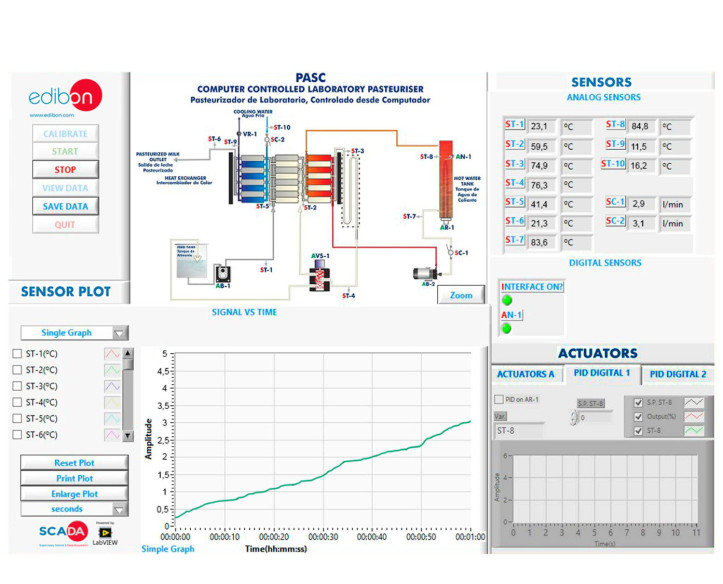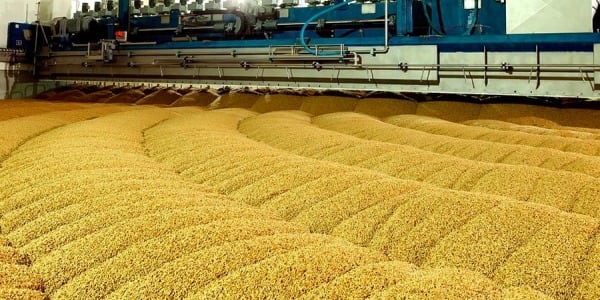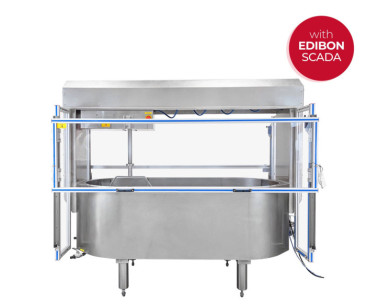PASC Laboratoire Pasteurisateur, Contrôlé par Ordinateur (PC)
SYSTEMES INNOVANTS
Le Laboratoire Pasteurisateur, Contrôlé par Ordinateur (PC), "PASC", conçu par EDIBON, est un pasteurisateur continu à petite échelle. Il effectue une pasteurisation HTST (High Temperature Short Time) qui simule les conditions de travail d’une usine réelle, mais permet de pasteuriser de petites quantités de produit en peu de temps, ce qui le rend économique et facile à comprendre pour l’étudiant.
Expansions
Laboratories
NOUVELLES LIÉES
Description Générale
Le Laboratoire Pasteurisateur, Contrôlé par Ordinateur (PC), "PASC", conçu par EDIBON, permet des conditions de flux continu avec des débits compris entre 1 et 30 l de produit par heure. Des températures allant jusqu'à 90 °C peuvent être obtenues et les temps de séjour et les efficacités peuvent être modifiés. L’élément principal du pasteurisateur de laboratoire est son échangeur thermique à plaques. Il est divisé en trois secteurs : chauffage, échange et refroidissement.
On peut distinguer une série d'étapes du processus de pasteurisation :
- Une première étape où est réalisé le préchauffage du produit alimentaire.
- Le pasteurisateur reçoit le produit du réservoir d'alimentation et le préchauffe dans la section centrale (interchangeable) de l'échangeur thermique, par circulation à courant croisé avec le produit pasteurisé et chaud.
- Ensuite, le produit passe à une deuxième étape de chauffage où la température du produit est augmentée jusqu'à une valeur suffisante pour éliminer les microorganismes élevés (72 °C environ), pendant un temps de maintien.
- Cette étape de chauffage est obtenue en faisant circuler le produit à courant croisé avec l'eau chaude du ballon où se trouve un élément chauffant.
- Le produit est maintenu à la température de pasteurisation pendant 15 à 20 secondes dans la section de rétention.
- Au lieu que le produit pasteurisé sorte à 72 °C, on le fait circuler en courant croisé avec le produit entrant à 4 °C, on obtient ainsi un double effet :
- Économies d'énergie lors du préchauffage du produit entrant de la température initiale de 4 °C à 56 °C. L'efficacité du processus de récupération d'énergie peut atteindre 75 %.
- Sortie du produit pasteurisé à la température de 40 °C, ce qui facilite la dernière étape.
- La dernière étape de l'échangeur de chaleur consiste à procéder au refroidissement du produit pour sa conservation. Pour ce faire, le produit passe dans le dernier secteur de l'échangeur thermique par circulation à courant croisé avec l'eau froide.
Le Laboratoire Pasteurisateur, Contrôlé par Ordinateur (PC), "PASC", permet également à l'étudiant de se familiariser avec un processus de nettoyage appelé CIP (Clean In Place) et s'effectue automatiquement par secteurs, comme c'est le cas dans les véritables installations de pasteurisation.
Cette Unité Contrôlée par Ordinateur est fournie avec le Système de Contrôle par Ordinateur EDIBON (SCADA), et comprend : l'Unité elle-même + un Boîtier d'Interface de Contrôle + une Carte d'Acquisition de Données + des Progiciels de Contrôle par Ordinateur, d'Acquisition de Données et de Gestion de Données, pour contrôler le processus et tous les paramètres impliqués dans le processus.
Des exercices et pratiques guidées
EXERCICES GUIDÉS INCLUS DANS LE MANUEL
- Etude de la pasteurisation HTST des produits alimentaires.
- Etude de la destruction des organismes nuisibles.
- Calibrage de la pompe d'alimentation péristaltique.
- Démarrage de l'usine de pasteurisation, fonctionnement avec de l'eau.
- Détermination de la relation entre la température de l'eau de chauffage en fonction du débit de liquide à pasteuriser.
- Détermination de la courbe de survie des différentes flores bactériennes.
- Détermination de la température seuil pour un temps de réchauffement constant du produit à traiter.
- Détermination du temps nécessaire pour obtenir un volume de stérilité souhaité.
- Détermination de la courbe du temps de réduction thermique.
- Etude et application du nettoyage CIP du pasteurisateur.
- Etude de différentes méthodes de nettoyage chimique.
- Calibrage des capteurs.
PLUS D'EXERCICES PRATIQUES À EFFECTUER AVEC CETTE ÉQUIPEMENT
- De nombreux étudiants voient les résultats simultanément. Pour voir tous les résultats en temps réel dans la classe au moyen d'un projecteur ou d'un tableau blanc électronique.
- Contrôle ouvert, multicontrôle et contrôle en temps réel. Cette unité permet intrinsèquement et/ou extrinsèquement de changer la durée, les gains, paramètres proportionnels, intégraux, dérivés, etc. en temps réel.
- Le système de contrôle informatique avec SCADA et Contrôle PID permet une véritable simulation industrielle.
- Cette unité est totalement sûre car elle utilise des dispositifs de sécurité mécaniques, électriques et électroniques.
- Cette unité peut être utilisée pour faire de la recherche appliquée.
- Cette unité peut être utilisée pour donner des cours de formation aux industries même à d'autres institutions d'enseignement technique.
- Contrôle du processus de l'unité PASC via la boîte d'interface de contrôle sans l'ordinateur.
- Visualisation de toutes les valeurs de capteurs utilisées dans le processus de l'unité PASC.
- Plusieurs autres exercices peuvent être faits et conçus par l'utilisateur.
UNITÉS SIMILAIRES DISPONIBLES
EQUIPEMENT COMPLEMENTAIRE
Unité Didactique d'Écremage du Lait, Contrôlée par Ordinateur (PC)
Unité Didactique d'Écremage du Lait
Unité Didactique de Production de Beurre, Contrôlée par Ordinateur (PC)
Unité Didactique de Production de Beurre
Unité UHT, Contrôlée par Ordinateur (PC) et Écran Tactile
Unité Didactique de Pasteurisation, Contrôlée par Ordinateur (PC)
Cuve de Coagulation Didactique, Contrôlée par Ordinateur (PC)
Unité Didactique de Presse à Fromage, Contrôlée par Ordinateur (PC)
Cuve Hollandaise pour la Production de Fromage (Jusqu'à 50L)
Incubateur de Yaourt Didactique, Contrôle par Ordinateur (PC)
Unité Didactique de Fromage Cottage, Contrôlée par Ordinateur (PC)
Unité pour la Fabrication de Fromage, Contrôlée par Ordinateur (PC)
Qualité

Service après vente

 Préférences sur les cookies
Préférences sur les cookies































